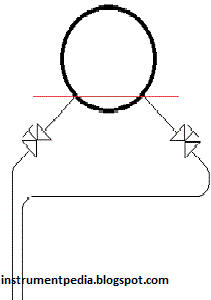How to calibrate Dp level transmitter at field
Material Required
Data sheet
Pressure calibrator (std)
Multimeter (std)
Hart communicator
Step
*Ask panel man to put the controller in manual mode for control loop and to put it on MOS for ESD loop.
*Hook up HART Communicator and verify some parameters by refer to data sheet. Typical parameters are, tag number, PV, LRV and URV.
*Isolate the instrument from the process.
*Release both pressure and drain low and high side liquid throughout manifold drain.
*Open both plug at seal pot
*Top up seal liquid for low side until half of seal pot.
*Remove tubing at high side of manifold
*Hook up pressure calibrator at high side and isolate the vent valve
*Hook up a multimeter in series with the signal to the DCS to measure current signal.
*Apply pressure as per calculation when level equivalent to zero
*Multimeter should show 4mA
*If not, do zero adjustment at transmitter using HART Communicator
*Apply pressure as per calculation when level equivalent to 100%Multimeter should show 20mA
If not, do span adjustment at transmitter using HART Communicator
*After completion of the job ask panel operator to put loops back in normal mode or normalize the MOS
*Fill the calibration form and file it for future reference.
Note:There is many way to perform calibration for DP level but the important thing is the DP reading at HART communicator should same with the LRV and URV
Example calculation:
Product S.G=0.89
Glycol S.G = 1.02
A= 2000mm (measurement length)
B= 100mm (off set)
C=A+B=2100mm
Dp = pressure at high side – pressure at low side
LRV = (B x Product S.G) – (A x Glycol S.G)
= (100mm x 0.89) – (2000 x 1.02)
= 89 – 2040
= -1951 mmH2O
URV = (C x Product S.G) – (A x Glycol S.G)
= (2100mm x 0.89) – (2000 x 1.02)
= 1869 - 2040
= -171 mmH2O
Note:
Calculation for apply pressure at high side manifold transmitter
0% = (B x Product S.G)
= (100mm x 0.89)
= 89 mmH2O
100% = (C x Product S.G)
= (2100mm x 0.89)
= 1869 mmH2O
Related post




